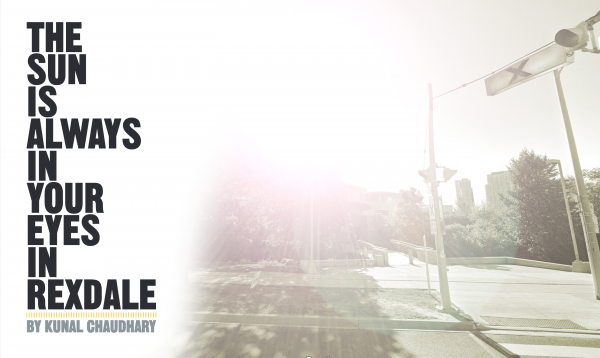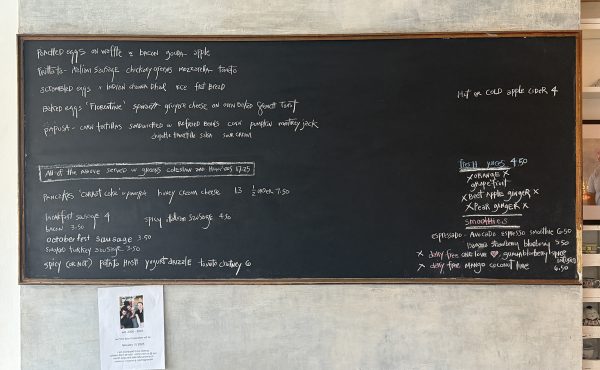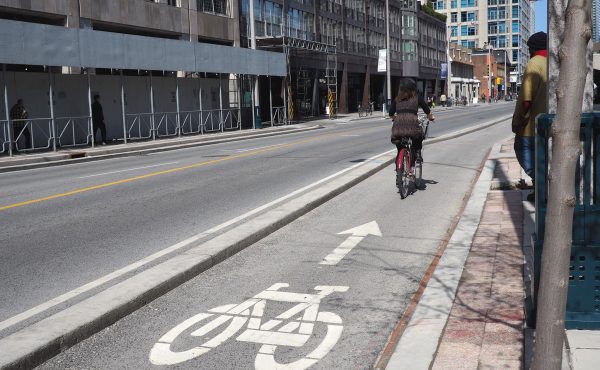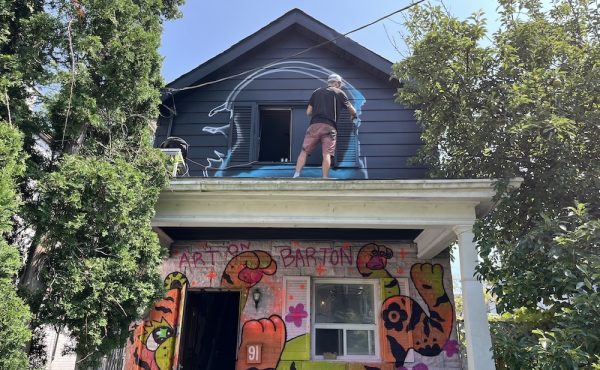This essay originally appeared in issue 57, summer 2021. The author, Kunal Chaudhary, has been nominated for the Best Emerging Writer at the 2022 National Magazine Awards.
On a perfectly idyllic afternoon in Rexdale 15 years ago, my brother and I stood in blue school uniforms on a street lined with scrawny trees and pale brick houses. A car idled on the road beside us. One skinny hand stuck out the window and pointed the silver barrel of a gun in our direction. The man holding the gun smiled, caught in a laugh. “What do you think about this?” he shouted. My brother pivoted his body in front of mine. We grimaced. This was the end we had been expecting.
At home, our parents interpreted the scene the only way they knew how. “What were they?” my father asked. My brother looked at him uncomprehendingly. “Were they brown? Black?” We knew the answer he expected, but the truth is that in Rexdale, the sun is in your eyes all the time. We couldn’t remember. My brother hastened a guess. “West Indian?” It was not good enough. My father called it a “freak incident,” and we never spoke of it again.
These Are Not the Stories I Tell
Years later, when I tell people I grew up in Rexdale, this is the kind of story they seem to want to hear. “How bad was it?” they’ll ask. Sometimes, I tell them about the time I almost got smoked on my way home from school. Other times, I allude to the fights, the first time I felt my fist press into flesh. These have all the elements of a good anecdote: tension, violence, catharsis.
They do not want to hear about our life growing up in a basement on Upper Humber Drive, in a house with a vegetable garden and an apple tree and the sounds of Highway 427 muffled behind a massive concrete divider at the end of our backyard. They do not want to hear about the subsidized swimming lessons at the Humber Community Pool, or the Sikh man who sold mangoes out of a van on the shoulder of Humberline Drive. Nor do they want to know about “Dr. Flea”, the elusive, Gatsby-like figure who ran the largest flea market in the city a short distance from our home, a place where we spent hours browsing bargain-bin clothes and video games before pooling all our cash for necessities. These are not the stories I tell.
My family immigrated to Canada and settled in Rexdale in 2002, shortly after 9/11 made the tint of our skin a liability in this country. Seeing the neatly-clipped lawns and uniform houses of Upper Humber Drive, my brother thought we had walked on to the set of Small Wonder. “This is heaven,” he said the first time we drove into the neighbourhood. My parents had asked their friends in Brampton for a home in the heart of the city. This was it.
For the first few years of our life in this country, we lived in crushing anonymity. In the gaze of early-aughts daily news and cable television, we did not exist. So we spent a lot of time moulding our voices, our clothes, and our mannerisms to mimic the whiteness we saw on screen. Even in a school where you could count the number of white kids on the fingers of one hand, whiteness was the norm. So we tried to adapt. We ate Black Diamond cheese with Wonder Bread, performed Christmas and Easter with cheap, imported traditions. In the absence of representation, we lived parodies of white lives.
In postcards, Toronto is the 15 square kilometres around the CN Tower — a glittering needle next to a dome crouched among skyscrapers. This Toronto sits at the centre of the Canadian national imaginary. To this day, I find it impossible to consolidate that image of the glittering city with the obscurity in which I grew up. Rexdale stood at the centre of nothing.
The Year of the Gun
All this changed in 2005. The number of gun-related deaths in the city doubled from the previous year as 52 people lost their lives. Five of these shootings happened in Rexdale. Media coverage of the gun violence in Toronto’s inner suburbs ramped up dramatically, often converging on racialized, low-income communities such as Rexdale, Jane and Finch, and Malvern. In our basement apartment, where TV news blared constantly, we stopped to listen every time “Rexdale” was mentioned on screen. The media dubbed it “the year of the gun”.
The previous year, a landmark study, Poverty by Postal Code, mapped the drift in concentrated poverty in Toronto from mixed-income communities downtown out to strictly working-class neighbourhoods in the suburbs of Etobicoke, North York, and Scarborough. The analysis spanned 20-odd years and found that there had been a “profound shift in the resident profile of higher poverty neighbourhoods, with ‘poor’ visible minority immigrant families making up far larger percentages of the total ‘poor’ family population in these neighbourhoods.” To combat the significant gaps in public infrastructure and services available to families living in places such as Rexdale, the study recommended a slew of material interventions including affordable housing, wage subsidies, employment programs, and the revitalization of public spaces.
Unfortunately, by August 2005, when the Toronto Star printed 33 guns on its front page, one for each shooting-related death in the city under the headline, “The Other Toronto,” the problem of Toronto’s poor, racialized inner suburbs had become indistinguishable from the anxious conversation surrounding guns and gang violence in the city. In other words, guns became the only story about our neighbourhood that mattered.
Amy Siciliano, then a PhD student at the University of Toronto, wrote her dissertation on the impact of the “year of the gun” on Toronto’s racialized poor. She spoke to policymakers, police, public-housing experts, health workers, and a broad selection of invested community members.
“Absent from popular discourse and official policy documents was the crucial fact that the sharp spike in gun violence was not a result of increasing concentrations of racialized poverty in the inner suburbs,” she wrote in Policing Poverty: Race, Space and the Fear of Crime after the Year of the Gun. Instead, she discovered it was actually the result of a massive gang raid conducted by Toronto police in 2004 that busted up the “Malvern Crew” — an alleged gang operation out of Scarborough. This raid, conducted under the banner “Project Impact”, led to 500 criminal charges and the arrest of 15 gang elders. It was the largest gang raid conducted in the city at the time.
Siciliano wrote that this raid specifically — and not the abstract evil of concentrated racialized poverty — set off the spike in shootings in 2005. As one of her research participants put it: “they busted up a bunch of these gangs and sent all of the gang elders to the clang and so there were a lot of 15-and-16-year-olds without elders who didn’t… understand that you’re not supposed to shoot up your neighbourhood, and so it was mayhem.”
Instead of addressing the threat that aggressive policing posed to Black and brown communities, then-mayor David Miller responded to the violence of the summer of 2005 with a plan for targeted investment in 13 new “priority neighbourhoods”—including Jamestown, in Rexdale. Meanwhile, the provincial government hired an additional 26 officers and 32 attorneys for its “guns and gangs task force.”
The perceived crisis of gun violence and the racialized communities it stemmed from came to a head on Boxing Day, 2005. Jane Creba, a white teenager out shopping near the Eaton Centre, was caught in the crossfire of a gang-related shooting and killed. According to Siciliano, this was when gun violence “penetrated the [overwhelmingly white and middle-class] social space of the urban core.” Despite the deaths of dozens of Black men that year as a result of gun violence, Creba’s death was declared the moment that Toronto lost its innocence. Days later, the provincial government earmarked an additional $51 million in the fight against gun crime in the GTA.
This was how gun violence in Toronto’s racialized inner suburbs ceased to be understood as a side-effect of sledgehammer policing and material deprivation and became, instead, a root-malignancy that only the police could excise. The criminalization of our communities was complete.
‘Guns and Gangs’
It did not matter that only one area within Rexdale had been designated as a priority neighbourhood. In the words of Toronto Star columnist Christopher Hume, Rexdale as a whole had become “shorthand for suburban blight, social breakdown, and gang violence.”
In school, the unctuous rhetoric of “guns and gangs” seeped down from our provincial legislature, through cracks in the media and education system, and rained down on our heads. Teachers gathered us together and led hushed discussions about gang violence, ubiquitously defining gangs for us as “a group of four or more people loitering without a purpose.” This definition was repeated to us in almost every conversation we had about gun violence. The administration held trade-in drives where we exchanged toy guns and gun-shaped toys for less alarming playthings — an experience not shared by friends who grew up white and middle-class. We were required to purchase mesh gym bags with the implicit (but universally understood) purpose of making it impossible to conceal a firearm. Explicitly and repeatedly, we were told not to wear “coloured bandanas or do-rags that might signal gang affiliation.”
I attended a school called Humberwood Downs that was part of a huge money pit on the edge of Rexdale known as the Humberwood Centre. This was a wide low-rise complex with a roof that looked like a set of raised eyebrows. It had been developed as a joint $23 million investment in a community with little access to public amenities outside its walls. The Centre housed two schools, a public library, a community centre, and a daycare. For the most part, the investment paid off in spades. The complex was an oasis in a resource desert. Humberwood Downs would eventually be described in the National Post as a school “as close to private as any in the Toronto District School Board.”
By the time the “year of the gun” rolled around, however, many of the students in Humberwood had already experienced the sensation of being viewed as essentially — or at least potentially — criminal. For years, our teachers and administrators informed us that the school had a “zero-tolerance policy” for “play-fighting.” This policy was enforced through innumerable detentions, suspensions, and exhortations that “play-fighting is real fighting.” The nebulousness of this definition made it so that anything from punching your friend in the arm to tackling someone during a game of tag could be grounds for punishment. For the child (almost always a boy) who failed to keep his hands to himself, the institutional response to “play-fighting” would be his first experience of criminalization.
Zero tolerance for “bad behaviour” in Ontario schools had been codified into the Education Act in 2000 by the Tory education minister Janet Ecker under an amendment called the Safe Schools Act. Starting in September 2001, the new law gave teachers the power to directly suspend students and sketched out a poorly-defined set of checks and balances in which such a move was appropriate. Most dramatically, according to the Ontario Human Rights Commission, the Act also provisioned “mandatory suspension and expulsion and police involvement… for a wide range of infractions.” Months before I moved to Rexdale, Ecker had introduced the language of policing into our schools and deployed the police as muscle in the retributive punishment of children.
Consider fighting: in the TDSB, fighting was grounds for mandatory suspension. If, as our teachers said, “play-fighting was real fighting”, then simple rough-and-tumble play was framed as pathological and criminal. When we did get into “serious” fights, the threat of zero-tolerance made it impossible for us to explore the frustrations and antagonisms that provoked them.
I got into my first real fight in 2004, with a boy named Navdeep. We had been messing with each other for weeks, and things came to a head one afternoon on the playground. He got me on the ground and struck me blindly a few times. I rolled him over and cracked my fist into his jaw. The second I did it, it turned my stomach. A rush of complex emotions — guilt, shock, horror — flooded my system. We caught sight of a teacher in our periphery and stopped immediately, sitting on the grass and pantomiming friendship till his gaze turned away. I remember recognizing, in the moment, that I was far more terrified of my teacher than I was of the boy throwing his fists at me. Fighting meant anything from detention to having the police called on you. Navdeep knew this too. So we sat there, nervously, and performed the absence of pain. We policed our bodies before they could be policed for us.
Eventually, Dalton McGuinty’s Liberal government overturned the Safe Schools Act. They replaced it with the Progressive Discipline and School Safety Act in 2007, primarily because of a complaint by the Ontario Human Rights Commission that demonstrated the disproportionate impact Ecker’s hardline legislation had on racialized, especially Black, students.
In 2005, however, the “year of the gun” exacerbated the criminalizing effect of the Safe Schools Act. As the constant barrage of noise about gun violence permeated our lives from the news, our parents and our teachers, it became clear to us as children that the adults we looked up to saw us as the source of all this troubling violence. The well-intentioned toy-gun drives, school assemblies, and extended conversations about signalling gang affiliation tinged the generous programming at Humberwood with paternalism and surveillance. Slowly, we grew aware that the pottery studio, the full industrial kitchen, the two libraries, the artist residencies, and the heavily-subsidized extracurricular programming were not there to lift our spirits and cultivate our minds but rather to contain our inherent destructiveness. Being children, we came to see ourselves this way too: as nuisances, burdens, scourges of the very society we had been struggling to assimilate into for years.
Our lives resisted this mythology of violence, of course. After school, the public library at the Humberwood Centre would be crowded with students elbowing each other for a spot on the computer. Others lounged about reading books by R.L. Stein and Roald Dahl. Humberwood students in our blue uniforms often jokingly play-acted Bloods and Crips with the maroon-clad students of Holy Child, the neighbouring Catholic school, before slumping to the foot of the bookshelves in the adult section to read in the hour before our parents picked us up. Our teachers put on galleries to celebrate our artwork and threw assemblies for all the holidays we celebrated that were never designated as a day off. They did have a talent for identifying the best in each child and nurturing it. Unfortunately, the perceived ubiquity of violence in our community muted the best of their efforts. It kept us scared, defensive, and distrustful of almost everyone around us.
If we felt this as South Asian children, the impact was only more pronounced on Rexdale’s Black children. At the time, my neighbourhood in Rexdale was 40% South Asian and 17% Black. As media saturation and systemic discrimination equated Blackness with chaotic and unpredictable violence, we were conditioned to draw a line between ourselves and our Black classmates. Of course, we were doing this long before Janet Ecker and Jane Creba. A virulent strain of anti-Blackness has existed in South Asian communities since time immemorial. We were the aggressors too.
Casual Colourism
Not long after we moved to our basement apartment on Upper Humber Drive, my mother began throwing great, profligate dinner parties for the network of Indian families that we had befriended in the community. In the absence of accessible public spaces, many immigrants in Rexdale turned their homes into ad-hoc community centres, privacy giving way to communion and commiseration. Imagine Trinity Bellwoods on a Saturday, but crammed into 700 windowless square feet.
As the darker of two brothers, I was often pulled aside by my aunties as they gossiped aloud about my complexion. They wondered if I would grow to lighten, and stood me beside my light-skinned brother to gawk. This sort of casual colourism is common in many South Asian households. Imported from the old country, it often blends seamlessly into the ambient anti-Blackness in this one. As children, we oscillated between the prejudices imposed by our parents and a more fundamental desire to engage with our Black classmates.
Here’s a story: in 2006, I made a friend named Imran. He was from Egypt and had shuttled around a handful of schools by the time I met him. Imran was the only other kid in my class who snuck novels into the folds of his textbooks and devoured them during math lessons. We became fast friends. He was whip-smart and boisterous, and had a habit of pulling me into a headlock when we walked together. For months, I would go home and regale my parents with stories about our playground adventures, the frenetic conversations we had that spanned all of recess and spilled into lunch.
A couple of months into this friendship, my parents met Imran at the Humber Community Pool. We tumbled in the water, dunked our heads below the surface and competed to see who could hold their breath the longest. Imran had a brown name and a Black body. He was just out of earshot when my parents pulled me aside and told me I should be more careful about my choice in friends.
I remember the way their warning cast a pall over our friendship. I began to see his boisterousness, his hyperactivity, with suspicion. Were these the signs of inevitable criminality? Was he one of the “bad influences” we were warned about? Most frighteningly: would he draw me in, make me a “bad kid” too? We grew distant. A few months later, he left and I never saw him again.
In the process of researching this article, I reminded my parents about Imran. They were mortified. “I’m ready to say mea culpa,” my dad said. “We were just so scared for you. I don’t know why we were scared.” Old friends I spoke to recall the way everyone punctuated insults with the N-word, the way we scapegoated our Black classmates at the first sign of trouble. We’re all mortified too.
Being From ‘That Place’
I left Rexdale in 2007, a few months after a teenager named Jordan Manners was shot and killed in a stairwell at C.W. Jefferys Collegiate Institute near Keele and Finch. We moved to Parkwoods, a similarly troubled but mercifully ignored corner of North York, on the edge of Scarborough.
It was only on my first day of school in Parkwoods that I realized none of what I had experienced in Rexdale was “normal”. In Parkwoods, there were no more toy-gun drives, no more fussing over colours, no more presumptions of inherent violence. Nobody felt the need to perform civility for our teachers.
As a matter of chance, one of my Black classmates from Humberwood had moved to the area at the same time our family did. I saw him during lunch, dressed in clothes I didn’t recognize, smiling in conversation with a kid I didn’t know. I was thrilled to see a familiar face, but when I went up to him to say hello, he dragged me aside by the arm and his expression turned grave. He told me he didn’t want people knowing he was from “that place”.
“We don’t know each other, okay?”
After the death of Jordan Manners, Premier Dalton McGuinty commissioned a task force to investigate the causes of youth violence and to “find out what might be done to address them to make Ontario safer in the long term.”
This task force eventually published a report called the Roots of Youth Violence that lucidly articulated the risk factors for violent crime. These included poverty, racism, poor community design, and criminalization through the education system.
“Poverty does not directly cause violent crime,” the report read, “but poverty without hope, poverty with isolation, poverty with hunger and poor living conditions, poverty with racism and poverty with numerous daily reminders of social exclusion can lead to the immediate risk factors for violence.”
It’s simple, the report seemed to say: the solution to violent crime has always been the alleviation of poverty and social isolation. The trouble with this narrative is in its very simplicity. There is real discursive comfort in framing conversations about material deprivation around gun violence. In 2006, when all those shootings went down, The Globe and Mail patted Toronto Police on the back for a job well done. Meanwhile, housing affordability continued to decline and the economic disparities between Toronto’s racialized inner suburbs and the downtown core continued to grow. The legacy media outlets that dictate the state of discourse in this city persisted with their grim fixation on gun violence while broadly neglecting the remainder of our lives. The Safe Schools Act was disbanded, but the Board of Education introduced police officers directly into “high-risk” schools in the city, including my high school. We were still expected to live invisibly, or as objects of suspicion worthy of surveillance.
And over the next decade, gun violence rose steadily too.
In 2018, the number of gun deaths in Toronto spiked again, and another “year of the gun” was enshrined into our collective history. Millions were poured into further policing. That year, I began my first job out of college as a teacher. Waiting for the subway, I would see “Rexdale” flash on the CP-24 news feed on the station video monitors, always in relation to another gun death, another shooting. Two years later, I would see Rexdale on the news again, soaked red on a map comparing infection rates of COVID-19 in the city — another institutional failure pinned on the people with whom I grew up, and whom I would watch fall ill one by one as the pandemic spread.
We are still waiting on a better story.
Kunal Chaudhary is a writer and English language teacher with a degree in English from the University of Ottawa and another in Journalism from the University of King’s College. He lives in Toronto with his plants.




